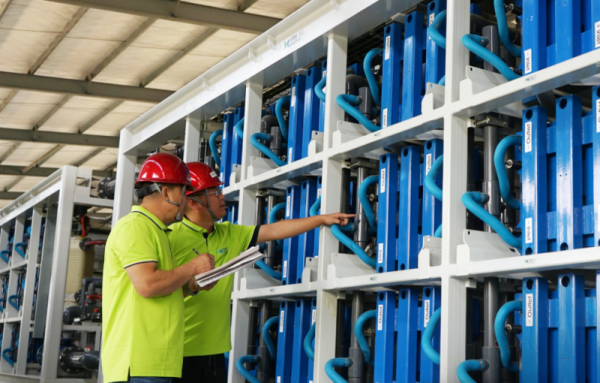VRB Energy, a Vancouver-based vanadium redox battery systems provider, said this week it has reached a framework deal to supply China’s largest solar battery, a 100-MW solar and storage project in Xiangyang, Hubei Province.
This news comes two years after a smaller-scale demonstration project was commissioned in the region.
VRB CEO Mianyan Huang said that among its advantages as a place to do business for the company, Hubei Province is rich in mineral resources.
“This presents a unique opportunity for scale-up of the vanadium flow battery industry, and we applaud the government’s plans to support development of a $14 billion world-leading vanadium energy storage industry cluster,” he said.
An initial 40MW / 200MWh first phase of the power plant’s VRB portion as well as the first phase of the factory’s construction are expected to begin in May.
The deal also includes a VRB-built manufacturing facility, as well as a research and development institute for flow battery technologies.
The company will also build the initial 50 MW of annual production capacity for a planned 1-GW “Gigafactory” in China.
Greening Power Grids
VBR chairman Robert Friedland said China wants to install over 1,000 GW of new solar PV and wind power by 2030.
“They are not alone in the commitment to decarbonization and the ‘greening’ of their power grids; with both the US and the European Union prioritising renewable power solutions,” he said.
“Energy storage remains a key challenge in the mass adoption of renewable energy, and we’re extremely proud to be leading the way in creating cutting-edge solutions.”
Redox battery systems store energy in liquid electrolyte in a process based on the reduction and oxidation of ionic forms of the element vanadium in a non-toxic process. Components can be nearly 100% recycled at end of-life, while improving lifecycle economics and environmental benefits compared to lithium-ion and other battery types.
VRB’s new role in the Hubei project joins a growing list of similar 100-MW flow battery projects Beijing is prioritising as part of its national energy-storage policy and accelerated infrastructure investment in support of economic growth post the Covid-19 pandemic.
Several provinces, from Xinjiang to Shandong, are now requiring minimums of 5% to 20% energy storage to be installed with new solar and wind power development, which will in turn increase vanadium demand going forward.
For the past several years, Beijing has also been pushing development of large vanadium flow battery projects.
Vanadium Stages Comeback
China has vast vanadium reserves in mineral form and also as a byproduct of steel production.
In 2019, the country was the world’s top vanadium-producer by far with output of 40,000 million tonnes, around the same level as the year before. Russia was the world’s second largest vanadium producer, placed at some 18,000 MT, followed by South Africa at 8,000 MT, and Brazil at 7,000 MT.
Vanadium, a rare earths metal, is one of several metals used in batteries’ electrolyte, and as such, comprises as much as 40% of its cost.
While the steel industry still dominates the vanadium demand base, growing attention is being given to the development of vanadium redox flow batteries.
Global markets for vanadium are staging a comeback one year after contraction due to the Covid-19 pandemic, with growth from both traditional and emerging end-use bases anticipated, along with price gains.
Vanadium in Europe, for example, has been seeing price hikes since the start of the year due to tighter supply than 2020, with a lack of availability from China and major European producers sold out until the end of March, according to an Argus report.
In the longer term, the demand side of the equation will dominate outlooks and bolster price expectations.
• Tim Daiss
This report was updated on Jan 11, 2022 for style purposes.
ALSO SEE:
Rare earth prices go through the roof as China tightens supply
China rapidly expanding Baotou rare earth high-tech zone
Battle for rare earths escalates as Pentagon gets involved
























